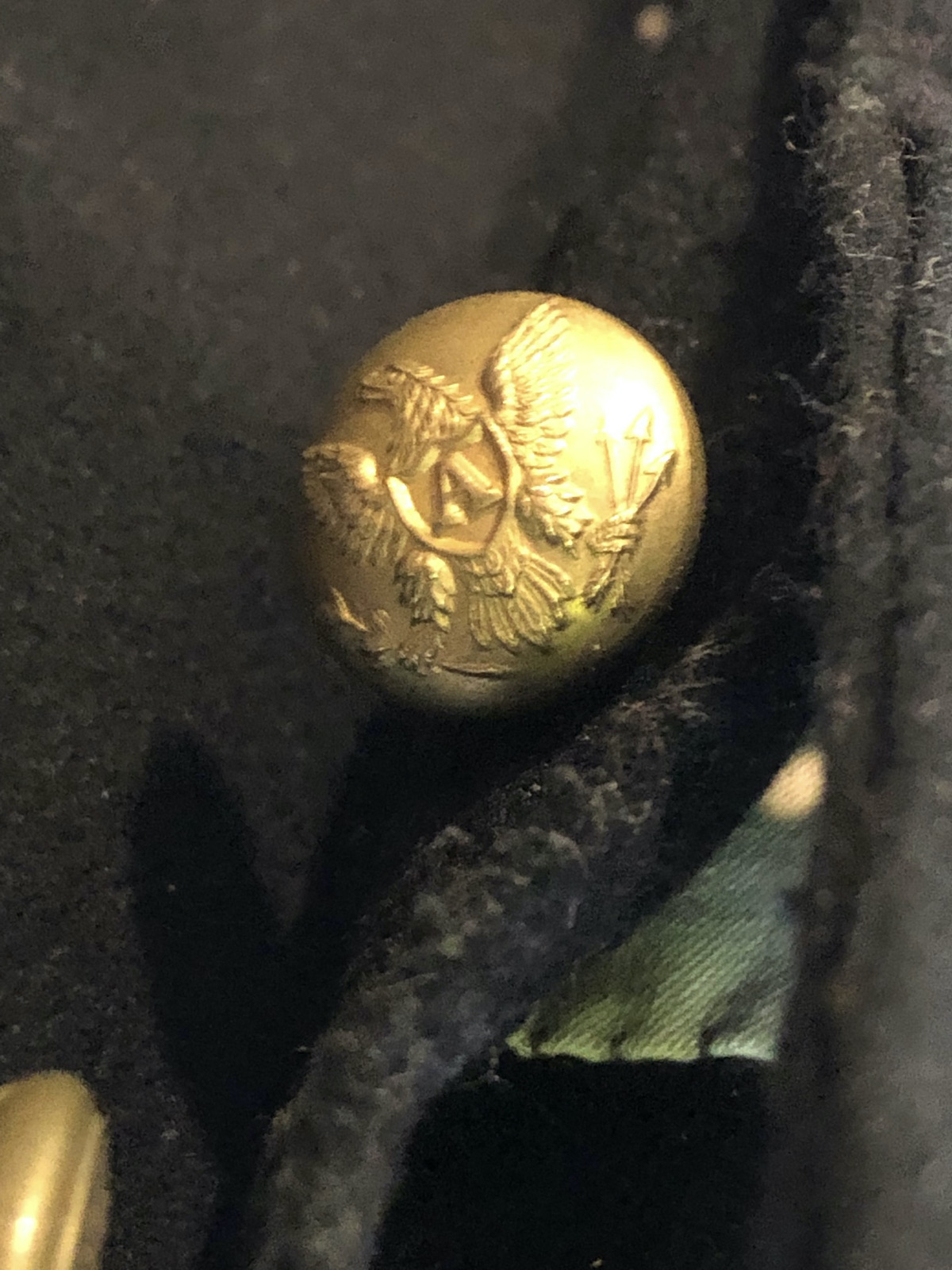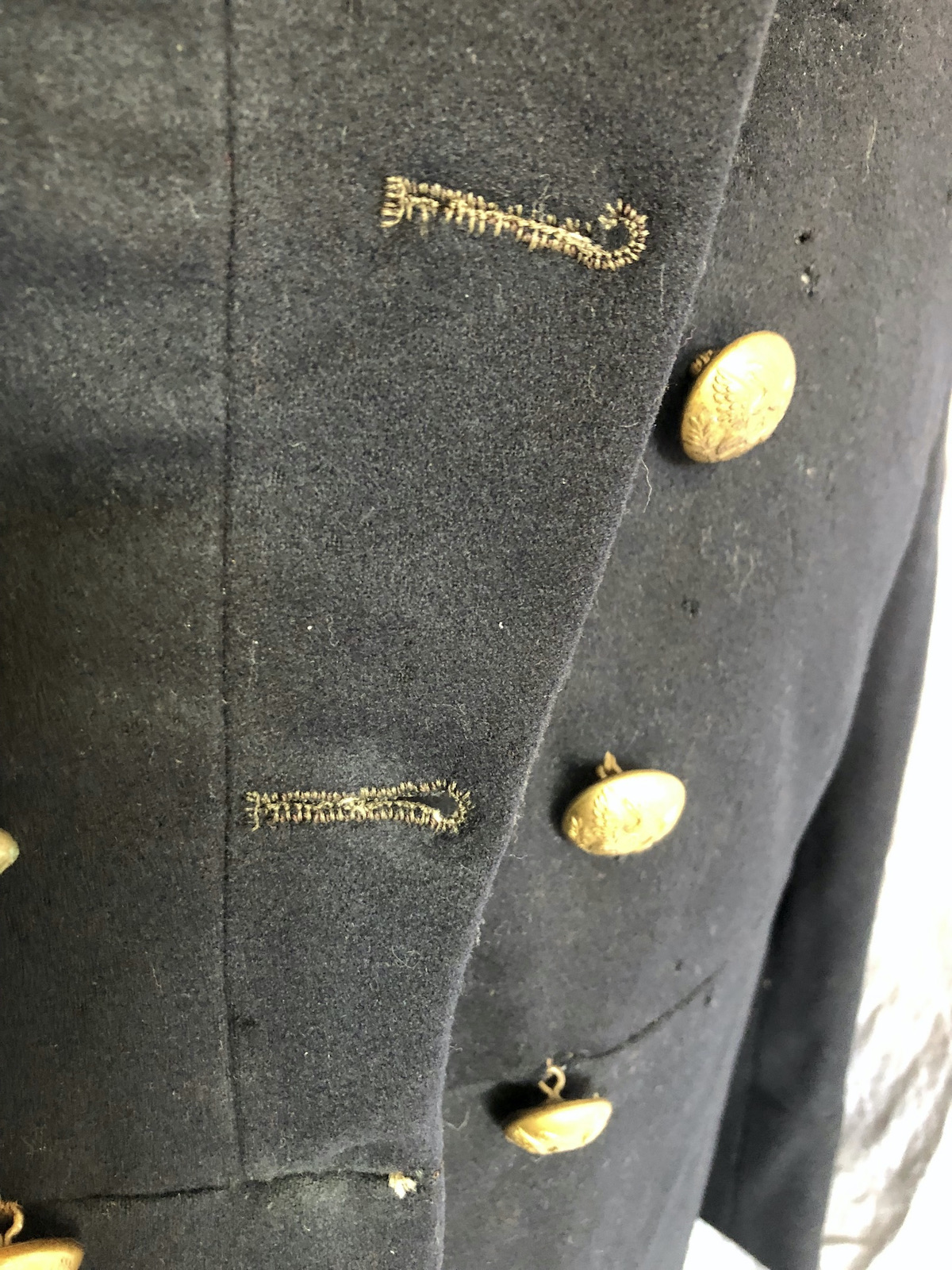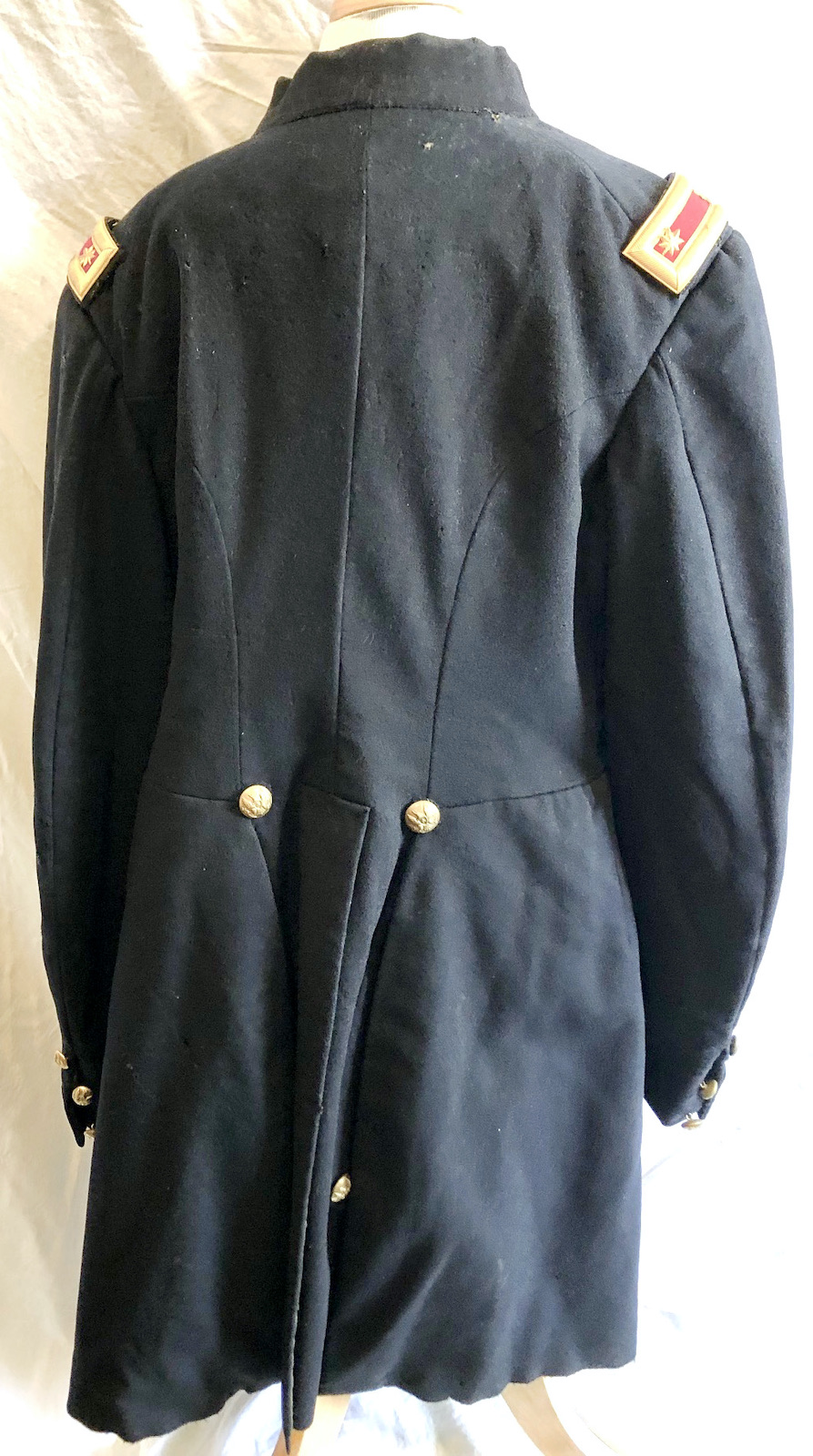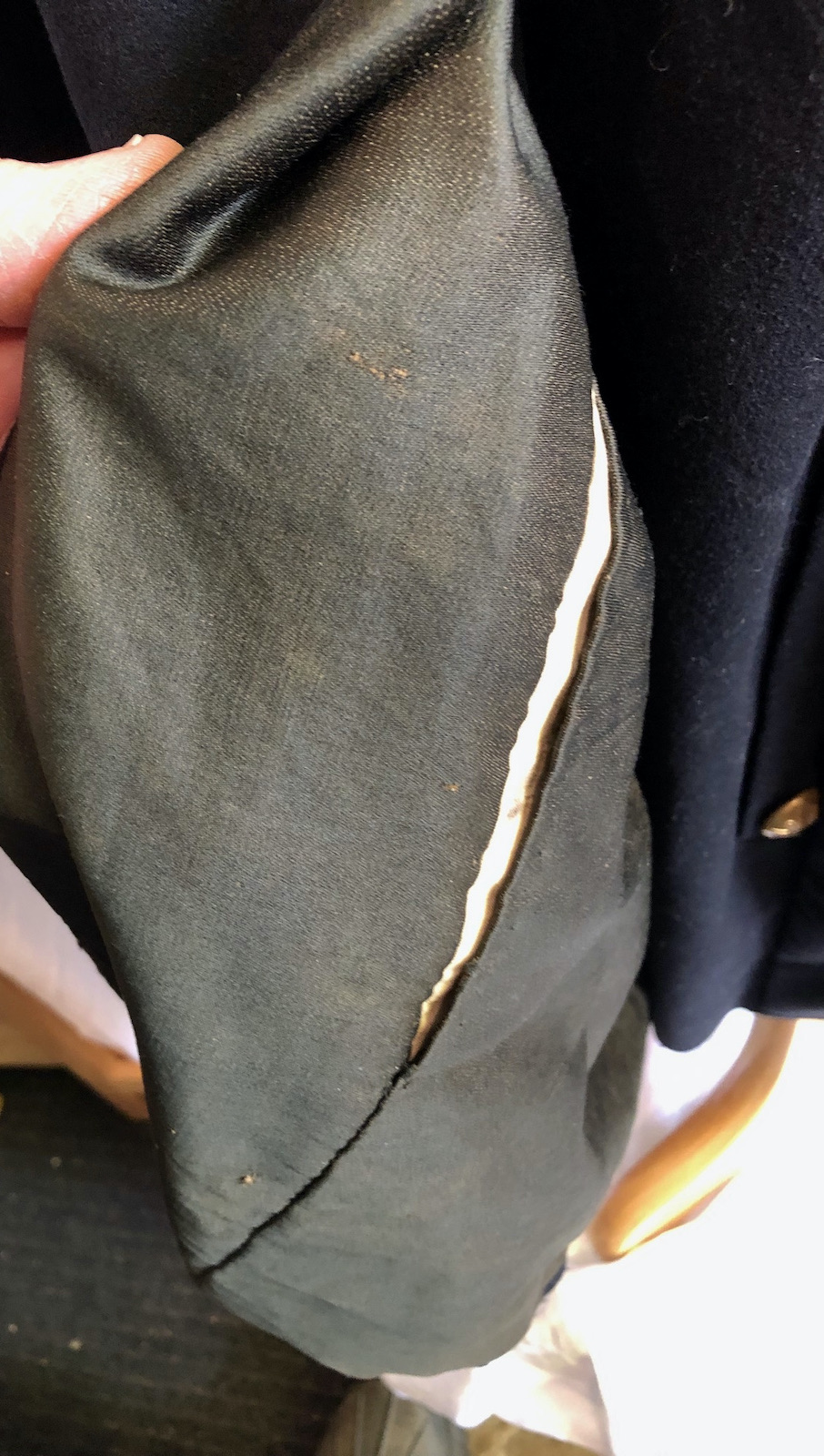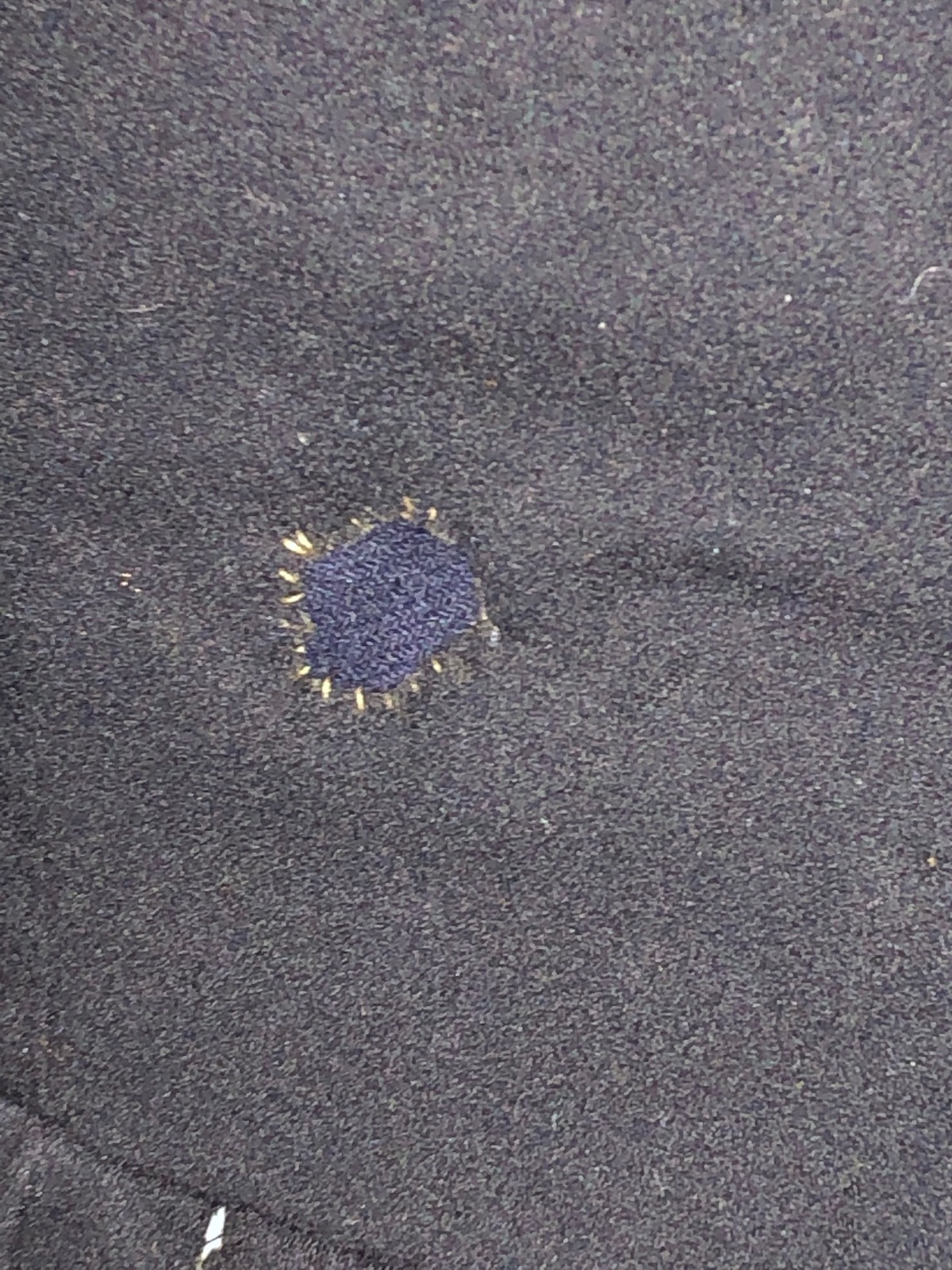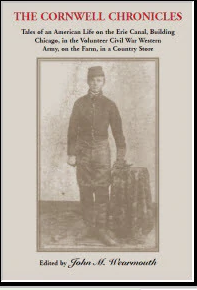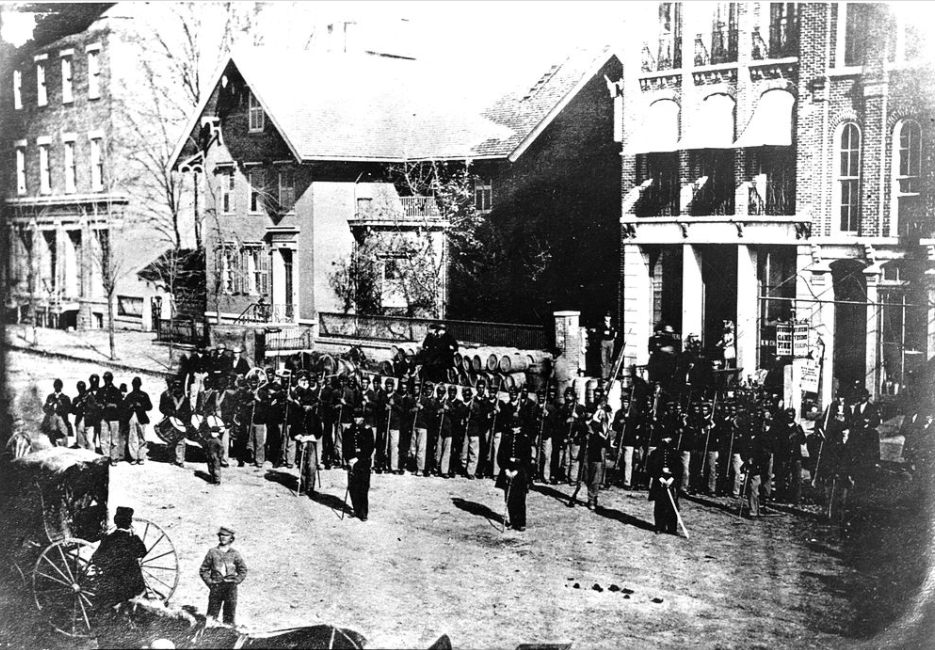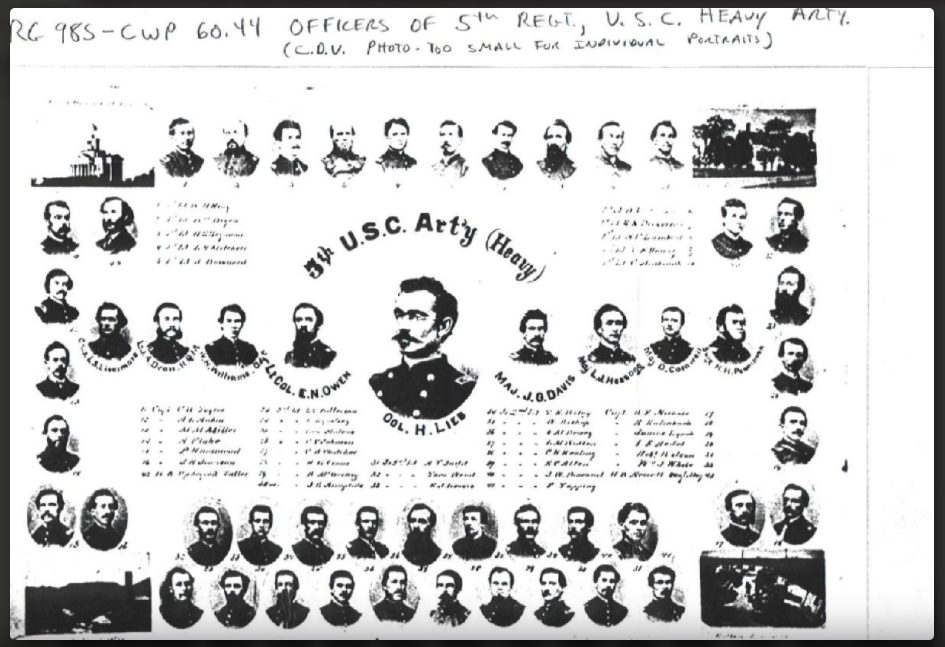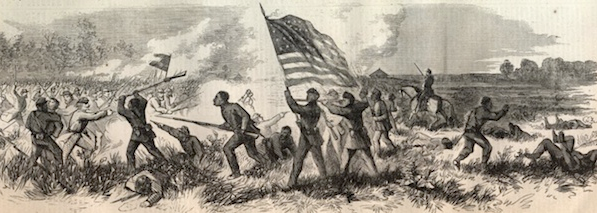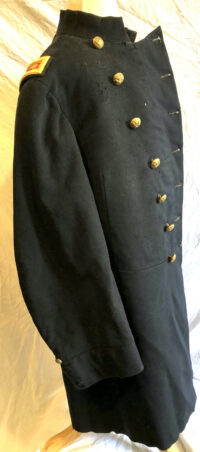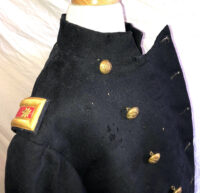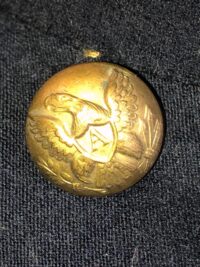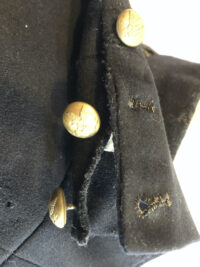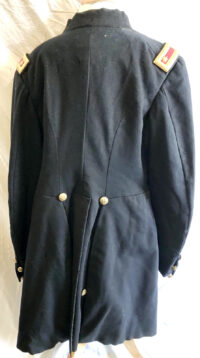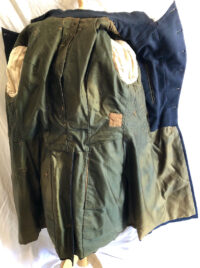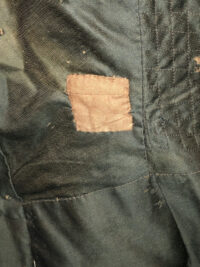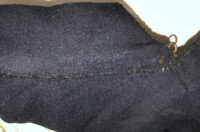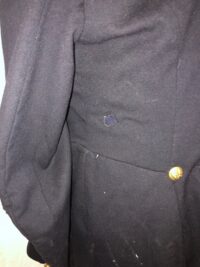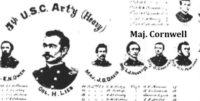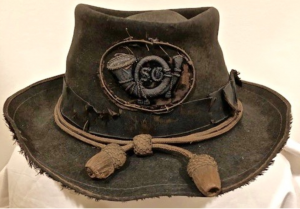Id’d Federal Major’s Coat Worn by Major David Cornwell 5th United States Colored Heavy Artillery
SOLD
Id’d Federal Major’s Coat Worn by Major David Cornwell 5th United States Colored Heavy Artillery – This finely tailored, original Civil War field grade officer’s frock coat was worn by Major David Cornwell during his service with the 4th and 5th United States Colored Heavy Artillery. David Cornwell, a young carpenter, by trade, enlisted, in July of 1861, at the rank of private, in the 8th Illinois Infantry, then transferred to the 1st Illinois Light Artillery. During service in the western theater of the war, Cornwell participated in the Battle of Milliken’s Bend, where the courage and combat prowess of USCT soldiers would serve to stifle doubters that Black troops would not participate adequately in combat. During this battle, Cornwell sustained a significant wound to his right shoulder; field surgeons wanted to amputate, but Cornwell refused the operation; he would retain the bullet in his arm for the rest of his life, rendering his right arm essentially useless. After recovering from his wound, Cornwell was commissioned in the 5th USCAB (United States Colored Artillery Battery or Battalion) or USCHA (United States Colored Heavy Artillery) as a Major. The latter regiment was initially organized, in 1863, from the 1st Mississippi Heavy Artillery (of African Descent), which in turn, was reassigned as the 4th United States Colored Heavy Artillery which, in turn, became the 5th USCHA. Cornwell’s commission as a Major of the Artillery appears on his records as occurring initially, in early December of 1863. Shortly after the war, Major Cornwell authored a book “The Cornwell Chronicles”; these memoirs, published after his death, recount, in great detail, his war service, including his activities as an officer in one of the first Black regiments to serve in the Western Theater of the war.
Major Cornwell’s frock coat remains in overall good condition; it does exhibit some relatively minor, but noticeable insect damage in a small area on the front of the coat. It exhibits the various characteristics that typify an original, Civil War period, Union officer’s frock coat – a substantially high collar, with japanned hook and loop fastener; per Federal regulations – fourteen front, large, Eagle A coat buttons, arranged in two rows of seven buttons per row; four coat size Eagle A buttons, two per tail, on the back skirts of the coat; the skirt and body lengths are approximately equal; the interior of the coat is fully lined, down to the unhemmed skirt bottoms, in a greenish, heavily quilted (in the chest area) and padded satinet; sleeve linings constructed of a high grade, striped linen (blue stripes are all even in size); two hidden coat tail pockets, lined in an off white, coarse cotton; three button cuffs, with two being functional; “ballooned” elbows about 9 inches across when laid flat; exterior of the coat constructed of a fine, deep blue, indigo-dyed, wool; all button holes are hand-whipped; a marked amount of hand sewing in the tailoring of the coat.
The coat exhibits some areas of minor wear, with some seam separations in the lining; of significant interest is a patched, bullet sized hole in the back mid-body area – this hole as repaired, in the period, from the inside of the coat, with a period patch of sky blue, kersey wool – on the interior, the hole and blue patch, was covered with a light brown patch of polished cotton; we firmly believe that this hole is indeed a bullet hole. Major Cornwell’s faux bullion, Smith’s patent, Major of the artillery, shoulder boards were initially found in the tail pockets of the coat; for that reason, both are in superior condition with the velvet fields retaining a vibrant red color.
Both tail pocket linings are stenciled – one with only Major Cornwell’s name:
“D. CORNWELL”
the other states the following:
“D. CORNWELL
MAJ. 4TH / 5TH U.S.C.A.B.”
This latter, stenciled enumeration is representative of Major Cornwell’s transition from the 4th USCAB to the 5th USCAB – the stenciling seemingly, originally listed the 4th USCAB (U.S. Colored Artillery Battalion); apparently, Major Cornwell crossed out the 4th regimental designation and hand wrote a ‘5th’ above it.
David Cornwell
| Residence Cairo IL; a 23 year-old Carpenter.Enlisted on 7/25/1861 at Cairo, IL as a Private.On 7/25/1861 he mustered into “Battery D” Co. IL 1st Light Artillery He was transferred out (date not stated)He also had service in:”K” Co. IL 8th Infantry He was described at enlistment as:5′ 9.5″, light complexion, blue eyes, light hairOther Information:born in New York |
1st LA Batty D IL Light Artillery Battery
( 3-years )
| Organized: Cairo, IL on 7/30/61 Mustered Out: 7/28/65 at Chicago, ILOfficers Killed or Mortally Wounded: 1 Officers Died of Disease, Accidents, etc.: 0 Enlisted Men Killed or Mortally Wounded: 7 Enlisted Men Died of Disease, Accidents, etc.: 28 (Source: Fox, Regimental Losses) |
| From | To | Brigade | Division | Corps | Army | Comment |
| Oct ’61 | Oct ’61 | Military Dist Cairo | Army and Dept of the Tennessee | New Organization | ||
| Oct ’61 | Feb ’62 | 4 | Military Dist Cairo | Army and Dept of the Tennessee | ||
| Feb ’62 | Feb ’62 | 2 | 1 | Military Dist Cairo | Army and Dept of the Tennessee | |
| Feb ’62 | Mar ’62 | 3 | 1 | District and Army of West Tennessee | ||
| Mar ’62 | Jul ’62 | Artillery | 1 | District and Army of West Tennessee | ||
| Jul ’62 | Nov ’62 | Unattached Arty | District of Jackson | District and Army of West Tennessee | ||
| Oct ’62 | Nov ’62 | Artillery | District Jackson, 13 | District and Army of West Tennessee | ||
| Nov ’62 | Dec ’62 | Artillery | 3 | Right Wing, 13 | District and Army of West Tennessee | |
| Dec ’62 | Nov ’64 | Artillery | 3 | 17 | Department of the Tennessee | |
| Nov ’64 | Mar ’65 | Artillery | District Nashville | Military Division of the Mississippi | ||
| Mar ’65 | Jul ’65 | 5th Sub District | District Middle TN | Department of Cumberland | Mustered Out |
ILLINOIS
1ST LIGHT ARTILLERY
BATTERY D., McALLISTER’S
(Three Years)
|
First Light Artillery.-Cols., Joseph D. Webster, Ezra Taylor; Lieut.-Cols., Charles H. Adams, Allen C. Waterhouse; Majs., Ezra Taylor, Charles C. Campbell, Charles M. Willard, Charles Houghtaling, Samuel B. Barrett, Allen C. Waterhouse, John T. Cheney, Raphael G. Rombauer, John A. Fitch.
Battery A of this regiment was called into service by Gov. Yates, in response to the first call of President Lincoln for troops. Its first appearance was on Sunday morning, April 2l, 1861, and at 9 p.m. it moved for Cairo via the Illinois Central railroad. On its arrival there it was assigned the duty of bringing to all downward bound boats with the view of preventing the shipment of contraband goods within the Confederate lines. The mode adopted for bringing boats to was to fire a blank shot in their direction, but on April 24, the steamer Baltic disregarded the blank shot, when a solid shot was fired across her bow, which had the desired effect. These shots were fired by squad 1, and they were the first that were fired across the river. After about a week’s stay at Cairo, the battery was ordered to take a position 2 miles above on the Mississippi river bank. The position was christened Camp Smith and was occupied by the battery nearly five months. The battery did not muster into the U.S. three months’ service, but was mustered into the three years’ service on July 16, 1861. On Sept. 6, it moved with Gen Grant to Paducah, where it remained until Feb. 4, 1862, participating in the various expeditions from that place, among which was the feint on Columbus simultaneous with Grant’s attack on Belmont. It occupied the Confederates, camp at Fort Heiman until Feb. 13, when it proceeded to Fort Donelson and upon its arrival opened fire at once, using canister in repelling the last decisive charges and firing 55 rounds. It took a conspicuous part in the battle of Shiloh, going into the fight at 8 a.m., of the first day, and retiring some time after 4 p.m. It was also engaged in the second day’s fight. In December it moved to Yazoo and took part in the Chickasaw bayou fight, being under fire about 4 hours and firing 807 rounds. It was engaged at Arkansas Post in Jan., 1863, and on May 17, marched to the Big Black river, to a place called Bridgeport, where it captured a Confederate lieutenant and 12 men. After the surrender of Vicksburg it moved with the division to Jackson and during the siege of that city lost 7 prisoners and 1 killed. It participated in the Atlanta campaign, first engaging the enemy at Resaca and then at Dallas. It took part in the engagements of July 19-21, losing 2 men, and on the 22nd, was attacked from the front and rear, and being overpowered by superior numbers was captured, many of the men being taken prisoners, while a number were killed and wounded. The remaining members of the battery took part in the grand move to the south of Atlanta, which culminated in the severe battle of Jonesboro and compelled the evacuation of Atlanta. The battery was ordered to Nashville during the campaign against Hood and from there it was sent to Chattanooga, remaining till the latter part of June, 1865, when it was ordered home for muster-out, arriving at Chicago July 3, where it received a royal welcome at the hands of its friends, who gave it a grand banquet in honor of its return.
Battery B was organized in April, 1861, and left in June, for Cairo where it lay for three weeks and then moved to Bird’s Point, Mo. One section of the battery participated in the fight at Frederickton in October. The entire battery went with Grant to Belmont on Nov. 7, going into action with 6 guns and coming out with 8 completely demolishing the Confederate battery. At Fort Donelson in W. H. L. Wallace’s brigade, the battery occupied the extreme right, fighting with scarce any intermission for 3 days. The day before the battle of Shiloh it was transferred to Sherman’s division and was ill that fight. It was also with him on the right at the siege of Corinth, was at LaGrange, Holly Springs and Memphis with Sherman, was at Chickasaw bayou, Arkansas Post, the siege of Vicksburg, Champion’s hill, Mechanicsburg and Richmond, La., and on May 1, 1864, moved with Sherman on his Atlanta campaign, taking part in the fights at Resaca, Dallas, Kennesaw mountain and many minor engagements. On July 12, 1864, the battery was ordered to Springfield that the men might be mustered out. It had 219 men altogether on its muster rolls and lost 16 by death, 6 in battle and 27 wounded.
Battery C, familiarly known as Houghtaling’s battery, was organized in the summer of 1861. The records of the adjutant- general’s office give no detailed account of its service, nor the dates when it was mustered in or mustered out. Its first service was about Cairo, Paducah and Bird’s point. With Morgan’s division it took part in the siege of Corinth; was then with Sheridan’s division in the Tennessee campaign; was engaged in the operations about Vicksburg; took part in the Chickamauga and Chattanooga-Ringgold campaigns; was with the 14th corps in the Atlanta campaign, and then formed part of the army in north Georgia and middle Tennessee. Wherever it was called into action it rendered a good account of itself, and of all the batteries from Illinois none achieved greater distinction than Houghtaling’s.
Battery D was organized at Cairo Sept. 2, 1861, and on Sept. 18, moved to Fort Holt, Ky. It was engaged in the siege of Fort Donelson, where 2 of its guns were disabled, and it also took part in the battle of Shiloh, taking eight positions during the action. The battery was commanded by Capt. H. A. Rogers during the campaign of Gen. Grant down the Mississippi, and back again to Memphis, then to Milliken’s bend and round to the rear of Vicksburg, during the battles of Raymond and Champion’s hill, and up to May 29, in the siege of Vicksburg, when he was shot dead by a minie-ball. During the winter of 1863-64 the battery was reorganized at Camp Fry, Chicago as a veteran battery. Returning to the scene of war, it left Vicksburg on April 5, 1864, on the campaign under Sherman through Georgia, and was in at the final capture of Atlanta. On July 22, it behaved with a coolness and bravery unsurpassed in the history of the war. It returned to Nashville, Tenn., was there during the last battle, and then went to Clarksville, where it remained until the order came for its muster out. The battery was mustered out of service at Chicago July 28, 1865.
Battery E was organized at Camp Douglas during the fall of 1861, and was mustered into service on Dec. 19. On Feb. 13, 1862, it was sent to Cairo, where horses, guns and all other necessary equipments were procured. On March 27, it took boat to Pittsburg landing arriving on the 30th, and received its baptism of fire at Shiloh on April 6, its casualties being 1 killed, 16 wounded and 1 missing. It participated in the movement on Corinth and then followed the line of the Memphis & Charleston railroad, skirmishing. camping, etc., till it reached Memphis, Tenn. On May 2, 1863, it went to Grand Gulf, Miss., thence to Jackson, and assisted in the capture of the latter place. Two days later it moved on Vicksburg, arriving on the 18th, and took an active part in the siege, losing 2 killed and 6 wounded. On July 5, it marched back to Jackson and assisted in a nine-days’ siege, when Johnston evacuated. In Feb., 1864, it had a skirmish at Wyatt, Tenn., on the Tallahatchie river, and in June, marched to Guntown Miss. and fought in the disastrous battle of Brice’s cross-roads, losing 1 killed, 3 wounded and 4 missing. In July, it marched on Tupelo, and fought at Pontotoc, Miss. The following day it was ambuscaded and lost 1 wounded. On July 14, it fought and whipped the Confederate Gen. Forrest at Tupelo, Miss. The time of enlistment of the battery expired Dec. 19, 1864, but it was not mustered out of service until the evening of Dec. 24, at Louisville, Ky.
Battery F was recruited at Dixon and was mustered in at Springfield Feb. 25, 1861. It moved to Benton barracks, Mo., March 15, with four 6-pounders. It was engaged in the siege of Corinth and on June 9, marched for Memphis, arriving on the 18th. It participated in the Vicksburg campaign and after the surrender of that city marched with Sherman to and participated in the siege of Jackson, Miss. From Jackson it returned to Vicksburg, where it remained until October, 1863, and then accompanied Sherman’s command to Memphis. It was a part of his army in the Chattanooga campaign, and on the night of Nov. 23, was one of the batteries placed in position on the north side of the river to cover the crossing of Sherman’s forces and prevent a hostile force moving to oppose him until he had taken position. The exact position of the battery was on a wooded knob, having a fire to the left and front, perfectly covering the ground in those directions and intended to repel any attack in the direction of the tunnel. It did very effective work in the actions which resulted in the complete rout of the enemy at Missionary ridge. It next marched on the Atlanta campaign, fired the first shot at the Confederate lines at Resaca, and continued to fire Effectively, advancing as the enemy retired and doing good service throughout the three-days’ operations. At the battle of July 22, before Atlanta, it was in the thickest of the fight, losing its caissons with all their implements and equipments after the entire support of the battery had been captured and a withdrawal under the circumstances was simply impossible. During the campaign beginning in May, and ending on Sept. 4, 1864, the battery lost 5 killed, 9 wounded and 1 missing. It accompanied the troops that followed Hood into Tennessee and participated in the campaign that ended in the complete rout of the enemy at Nashville. On March 7, 1865, the battery was consolidated with other batteries in the regiment.
Battery G was organized at Cairo and was mustered in Sept. 28, 1861. On March 18, 1862, it moved to Columbus, Ky., thence to Island No. 10 and New Madrid as garrison and returned to Cairo April 11. On the 13th, it moved down the river to Fort Pillow and on the 16th, returned. On April 22, it moved to Hamburg, Tenn., was engaged in the siege of Corinth in May, and in the battle of Corinth in October. It participated in the Vicksburg campaign and after the surrender of that city engaged in the operations in Mississippi and Tennessee, being a part of the force that repelled the attack upon Memphis in Aug. 1864. The battery was mustered out of service at Camp Butler July 24, 1865.
Battery H was recruited in and about Chicago during Jan. and Feb., 1862. In March, it was ordered to St. Louis, where it was equipped with 20-pounder Parrott’s as a 4-gun battery and was immediately sent down the river to join Gen. Grant’s command. It arrived at Pittsburg landing April 5, and participated in the battle of Shiloh the next day forming the center of that line of artillery which, with the gun-boats on the Tennessee, repulsed the last charges of the Confederates on the first day of the battle. The battery participated in all of the battles in which the 15th corps was engaged and was one of the working companies of that famous corps at Vicksburg, Missionary ridge, the Atlanta campaign, the march to the sea, finally marching in review before the president at Washington and was mustered out with the rest of the 15th corps. The guns were captured on July 22, 1864, in front of Atlanta, but were soon recaptured and turned with good effect upon the retreating enemy.
Battery I was organized at Camp Douglas and was mustered in Feb. 10, 1862. 0n March 1, it moved to Benton barracks, Mo., and in April, was engaged in the battle of Shiloh. In May, it was in the siege of Corinth and afterward moved to Memphis. It went on an expedition into Arkansas in October, and afterward into Mississippi, where it engaged the enemy’s cavalry. It remained at Memphis until Nov. 28, when it participated in the Tallahatchie raid, then returned to LaGrange and Holly Springs, and finally to Moscow, Tenn. It was engaged in the Vicksburg campaign, then moved with Sherman’s army and participated in the siege of Jackson, after which it returned to the Black river. It moved under Gen. Sherman via Memphis and Corinth to Chattanooga and was engaged in the battles there in November. It veteranized on March 17, 1864, and went to Illinois on furlough. Returning to the field it participated in the battle of Nashville, and was mustered out July 26, 1865.
Battery K was organized at Shawneetown and mustered into the service Jan. 9, 1862. The first year’s service of this battery was in chasing guerrillas through Kentucky, chiefly in and about Perryville. It formed a part of Burnside’s expedition, participating in all its arduous service in connection with the 1st cavalry division of the army to which it had been attached. It was the first battery in East Tennessee and was foremost in the capture of Knoxville. During its service in Tennessee it was attached to the brigade of which the 14th Ill. cavalry formed a part, the history of which will be found on another page of this volume. A part of the men were mustered out at Springfield in June, 1865, and the remainder at Chicago in the month following.
Battery L, “Rourke’s Battery ” like battery C, was never reported in detail by the adjutant-general. Its service was chiefly in Virginia with Gen. B. F. Kelley’s command and Porter’s division, though on Sept. 19, 1862, it was transferred to the Department of the Ohio for a short time. It then returned to Virginia and took part in the Mine Run campaign and the operations in the Shenandoah Valley. It was frequently engaged with the enemy and always with credit to itself and the state which sent it forth.
Battery M was organized at Camp Douglas and mustered into the service Aug. 12, 1862 for three years. On Sept. 27, it left for Louisville, where it did garrison duty until Nov. 11. The first real engagement in which it participated was Chickamauga, where during the second day’s fighting it repulsed Gen. Longstreet repeatedly, losing 2 men killed, 14 wounded and 16 horses killed. On Sept. 21, the battery was placed at Ringgold gap of Missionary ridge, whence it shelled the Confederate cavalry that appeared in the valley beyond. On Nov. 2, it drove away a lot of Confederates who had begun to fortify in front of Fort Negley, and on the 25th, it fired its last shot at Gen. Bragg from its position near the fort. In May, it started on the Atlanta campaign, and participated in all the marches, battles and skirmishes until Sept. 5, near Lovejoy’s Station, where it fired its last shot at the Nation’s foes. The members of the battery returned to Atlanta, and being so worn out were sent to Chattanooga Nov. 1, and did garrison duty there, at Cleveland and Charleston, Tenn., until July 14, 1865, when they started for Chicago, where they were mustered out July 4, 99 strong. It had 7 commissioned officers, 170 men mustered in, 157 detailed men, lost 2 killed in battle, 1 detailed man killed, 1 man died of wounds, 2 killed by accident, 7 died of disease, 1 taken prisoner, 31 previously discharged, 7 transferred, 22 deserted, 16 wounded and 39 horses killed. It traveled 3,102 miles, fired 7,845 rounds at the enemy, and was under fire 178 days.
David Cornwell
51st UC Infantry
Fifty-first U. S. Colored Infantry
|
David Cornwell
| Residence was not listed;
Enlisted on 12/1/1863 at Vicksburg, MS as a Major. On 12/1/1863 he was commissioned into “F” Co. US CT 5th Heavy Artillery (date and method of discharge not given) (Estimated date of enlistment)
Intra Regimental Company Transfers: * from company F to company B |
5th UC Heavy Artillery
( 3-years )
| Organized: Vicksburg, MS on 12/1/63 Mustered Out: 5/20/66Officers Killed or Mortally Wounded: 4 Officers Died of Disease, Accidents, etc.: 4 Enlisted Men Killed or Mortally Wounded: 124 Enlisted Men Died of Disease, Accidents, etc.: 697 (Source: Fox, Regimental Losses) |
| From | To | Brigade | Division | Corps | Army | Comment |
| Mar ’64 | Nov ’64 | Unattached | 1st Colored | Department of the Tennessee |
UNITED STATES COLORED TROOPS.
5th REGIMENT HEAVY ARTILLERY.
|
Organized from 1st Mississippi Heavy Artillery (African Descent). Designated 4th Heavy Artillery March 11, 1864, and 5th Heavy Artillery April 26, 1864. Attached to 1st Division, United States Colored Troops, District of Vicksburg, Miss., to February, 1865. Unattached, Post of Vicksburg, Dept. of Mississippi, and Dept. of the Gulf to May, 1864.
SERVICE.—Garrison duty at Vicksburg, Miss., till May, 1866. Expedition from Vicksburg to Rodney and Fayette September 29-October 3, 1864. Expedition from Vicksburg to Yazoo City November 23-December 4, 1864. Mustered out May 20, 1866.
Lost during service 4 Officers and 124 Enlisted men killed and mortally wounded and 697 Enlisted men by disease. Total 829. |
David Cornwell
| Residence was not listed;
Enlisted on 11/1/1863 at Milliken’s Bend, LA as a Private.
On 11/1/1863 he mustered into “B” Co. US CT 51st Infantry (date and method of discharge not given) (Estimated date of enlistment) |
51st UC Infantry
( 3-years )
| Organized: Milliken’s Bend, LA on 11/1/63 Mustered Out: 6/16/66 |
| From | To | Brigade | Division | Corps | Army | Comment |
| Dec ’64 | Feb ’65 | 1 | 1st Colored | Department of the Tennessee | ||
| Feb ’65 | Jun ’65 | 2 | 1 | Corps de Afrique | Army and Dept of the Gulf | |
| Feb ’65 | Jul ’65 | 2 | 1 | District West FL | Army and Dept of the Gulf |
Fifty-first U. S. Colored Infantry
| Organized March 11, 1864, from 1st Mississippi Infantry (African Descent). Attached to
Post of Goodrich Landing, District of Vicksburg, Miss., to December, 1864. 1st Brigade, 1st Division, United States Colored Troops, District of Vicksburg, Miss., to February, 1865. 2nd Brigade, 1st Division, Steele’s Command, Military District of West Mississippi, to June, 1865. Dept. of the Gulf to June, 1866.
SERVICE.-At Lake Providence till May, 1864. Post and garrison duty at Goodrich Landing, La., till December, 1864. Action at Langley’s Plantation, Issaquena County, March 22, 1864. Flod, La., July 2. Waterford August 16-17. Duty at Vicksburg, Miss., till February, 1865. Moved to Algiers, La., February 26; thence to Barrancas, Fla. March from Pensacola, Fla., to Blakely, Ala., March 20-April 1. Siege of Fort Blakely April 1-9. Assault and capture of Fort Blakely April 9. Occupation of Mobile April 12. March to Montgomery April 13-25. Duty there and at Mobile till June. Ordered to New Orleans, thence to Texas. Duty on the Rio Grande and at various points in Texas till June, 1866. Mustered out June 16, 1866. |
David Cornwell
| Residence Cairo IL; a 23 year-old Carpenter.
Enlisted on 7/25/1861 at Cairo, IL as a Private.
On 7/25/1861 he mustered into “Battery D” Co. IL 1st Light Artillery He was transferred out (date not stated) He also had service in: “K” Co. IL 8th Infantry He was described at enlistment as: 5′ 9.5″, light complexion, blue eyes, light hair Other Information: born in New York |
1st LA Batty D IL Light Artillery Battery
( 3-years )
| Organized: Cairo, IL on 7/30/61 Mustered Out: 7/28/65 at Chicago, ILOfficers Killed or Mortally Wounded: 1 Officers Died of Disease, Accidents, etc.: 0 Enlisted Men Killed or Mortally Wounded: 7 Enlisted Men Died of Disease, Accidents, etc.: 28 (Source: Fox, Regimental Losses) |
| From | To | Brigade | Division | Corps | Army | Comment |
| Oct ’61 | Oct ’61 | Military Dist Cairo | Army and Dept of the Tennessee | New Organization | ||
| Oct ’61 | Feb ’62 | 4 | Military Dist Cairo | Army and Dept of the Tennessee | ||
| Feb ’62 | Feb ’62 | 2 | 1 | Military Dist Cairo | Army and Dept of the Tennessee | |
| Feb ’62 | Mar ’62 | 3 | 1 | District and Army of West Tennessee | ||
| Mar ’62 | Jul ’62 | Artillery | 1 | District and Army of West Tennessee | ||
| Jul ’62 | Nov ’62 | Unattached Arty | District of Jackson | District and Army of West Tennessee | ||
| Oct ’62 | Nov ’62 | Artillery | District Jackson, 13 | District and Army of West Tennessee | ||
| Nov ’62 | Dec ’62 | Artillery | 3 | Right Wing, 13 | District and Army of West Tennessee | |
| Dec ’62 | Nov ’64 | Artillery | 3 | 17 | Department of the Tennessee | |
| Nov ’64 | Mar ’65 | Artillery | District Nashville | Military Division of the Mississippi | ||
| Mar ’65 | Jul ’65 | 5th Sub District | District Middle TN | Department of Cumberland | Mustered Out |
5th United States Colored Heavy Artillery Regiment
| 9th Regiment, Louisiana Infantry (African Descent) 1st Regiment, Mississippi Colored Heavy Artillery 5th Regiment, U.S. Colored Heavy Artillery |
|
| Active | May 1, 1863 – May 20, 1866 |
| Country | United States of America |
| Allegiance | Union |
| Branch | Union Army |
| Type | Infantry Heavy Artillery |
| Size | Regiment |
| Engagements | American Civil War
· Expedition to Rodney and Fayette |
| Commanders | |
| Notable commanders |
Col. Hermann Lieb |
The 9th Louisiana Infantry (African Descent), later reorganized as 1st Mississippi Colored Heavy Artillery and then renamed 5th U.S. Colored Heavy Artillery, was an African-American regiment in the Union Army during the American Civil War. It famously fought in the Battle of Milliken’s Bend; one of the earliest Civil War battles with African-American troops involved.
Original regimental organization and service
The creation of the regiment was authorized by Adjutant General Lorenzo Thomas, who had gone west to recruit colored troops, on April 14, 1863; and it was organized on May 1 at Vicksburg, Mississippi. Because of the irregular practice to establish all 10 companies at once and to divide new recruits equally among them, none of the companies had the needed strength to be mustered according to the regulations.[1] The 9th had an all-white officer corps that, with the exception of the regimental command staff, was entirely composed of former enlisted volunteer soldiers.[2]
The original regimental command and staff officers were:[2][3]
- Colonel: Hermann Lieb(Major, 8th Illinois Infantry)
- Lieutenant Colonel: Charles L. Page (Captain, 20th Illinois Infantry)
- Major: Erastus N. Owen (1st Lt., 20th Ohio Infantry)
- Adjutant: 1st Lt. Russell B. Neal (2nd Lt., 20th Ohio Infantry)
- Quartermaster: 1st Lt. Charles M. Clark (Quartermaster Sergeant, 8th Illinois Infantry)
While participating in the Vicksburg Campaign Colonel Lieb, in overall command, led his 285 men[4] into the Battle of Milliken’s Bend. In the close-combat battle the regiment lost some 62 killed and 130 wounded, the number of missing men not being given. Its 67% total losses makes it among the highest of any unit during the Civil War.[5] On the same day the unit fought in the follow-up Battle of Young’s Point. Afterwards the companies were restructured and finally, on August 7, 1863, the regiment was formally mustered into Federal service.[6]
Jack Jackson
One early recruit to join the regiment was named Jack Jackson. Jackson was said to be very large and strong-willed and quickly became a Sergeant in Company B. At some point Jackson joined the regimental recruiting parties; the officers were having trouble with convincing local field hands to join. Jackson’s recruiting method was described as very forceful but ultimately successful.[7] At the Battle of Milliken’s Bend one of Jackson’s superior officers, Lieutenant David Cornwell, described the attack; saying that the 23rd Iowa was not behaving courageously but the three black infantry regiments offered great resistance. He said that Jackson, “Laid into a group of Texans… smashing in every head he could reach”, and that, “Big Jack Jackson passed me like a rocket. With the fury of a tiger he sprang into that gang and crushed everything before him. There was nothing left of Jack’s gun except the barrel and he was smashing everything he could reach. On the other side of the levee, they were yelling ‘Shoot that big [soldier]!’ while Jack was daring the whole gang to come up and fight him. Then a bullet reached his head and he fell full on the levee.”[8][9]
Later reorganizations
In September 1863, still at Vicksburg, the regiment began a reorganization process owed to the formal establishment and enlargement of the United States Colored Troops. On September 26 it was converted into an artillery unit, becoming the 1st Regiment, Mississippi Heavy Artillery (African Descent). Still commanded by Colonel Lieb, it was designated 4th U.S. Colored Heavy Artillery in March 1864 before finally becoming the 5th U.S. Colored Heavy Artillery a month later.[10] Under that designation it participated in the Expedition to Rodney and Fayette and the Yazoo City Expedition.
The 5th was mustered out on May 20, 1866.[11] Its losses were given as 4 officers and 124 enlisted men killed and mortally wounded; 4 officers and 697 enlisted men dead by disease for a total of 829.[12][13][14]
Meanwhile, when the regiment received the Mississippi designation a new 9th Louisiana Infantry (African Descent) was formed. Like the old 9th, it was renamed with the formalization of the USCT; it became the 63rd U.S. Colored Infantry Regiment on March 11, 1864. That unit, commanded by Colonel John Eaton, served in Mississippi, Louisiana, Arkansas, and Tennessee, and was mustered out on January 9, 1866.[15]
| NAME: | David Cornwell |
| ENLISTMENT AGE: | 23 |
| BIRTH DATE: | 1838 |
| BIRTH PLACE: | New York |
| ENLISTMENT DATE: | 25 Jul 1861 |
| ENLISTMENT PLACE: | Cairo, Illinois |
| ENLISTMENT RANK: | Private |
| MUSTER PLACE: | Illinois |
| MUSTER COMPANY: | K |
| MUSTER REGIMENT: | 8th Infantry |
| MUSTER REGIMENT TYPE: | Infantry |
| MUSTER INFORMATION: | Transferred |
| SIDE OF WAR: | Union |
| SURVIVED WAR?: | Yes |
| COMPLEXION: | Light |
| EYE COLOR: | Blue |
| HAIR COLOR: | Light |
| HEIGHT: | 5 ft, 9 1/2 inches |
| RESIDENCE PLACE: | Cairo, Illinois |
| OCCUPATION: | Carpenter |
| ADDITIONAL NOTES 2: | Muster 2 Date: 25 Jul 1861; Muster 2 Place: Illinois; Muster 2 Unit: 440; Muster 2 Company: Battery D; Muster 2 Regiment: 1st LA; Muster 2 Regiment Type: Artillery; Muster 2 Information: Enlisted; |
| NAME: | David Cornwell |
| RANK: | Private |
| COMPANY: | D |
| UNIT: | 1st Illinois Light Artillery |
| HEIGHT: | 5′ 9 1/2 |
| HAIR: | LIGHT |
| EYES: | BLUE |
| COMPLEXION: | LIGHT |
| OCCUPATION: | Carpenter |
| BIRTH DATE: | Abt 1838 |
| BIRTH PLACE: | NY |
| WAR: | Civil War |
| WAR YEARS: | 1861-1865 |
| SERVICE ENTRY AGE: | 23 |
| SERVICE ENTRY DATE: | 25 Jul 1861 |
| PERIOD: | 3 YRS |
| REMARKS: | TRANS FROM CO K 8 ILL INF |
| NAME: | David Cornwell |
| GENDER: | Male |
| BIRTH DATE: | 19 Dec 1838 |
| BIRTH PLACE: | Watertown, Jefferson County, New York, United States of America |
| DEATH DATE: | 1 May 1911 |
| DEATH PLACE: | Allegan, Allegan County, Michigan, United States of America |
| CEMETERY: | Oakwood Cemetery |
| BURIAL OR CREMATION PLACE: | Allegan, Allegan County, Michigan, United States of America |
| HAS BIO?: | Y |
| FATHER: | Joshua Cornwell |
| MOTHER: | Charity L Cornwell |
| SPOUSE: | Sarah Anna Cornwell; Frances Felicia Cornwell |
| CHILDREN: | Edith Cornwell |
David Cornwell
| BIRTH | 19 Dec 1838
Watertown, Jefferson County, New York, USA |
| DEATH | 1 May 1911 (aged 72)
Allegan, Allegan County, Michigan, USA |
| BURIAL | Oakwood Cemetery
Allegan, Allegan County, Michigan, USA |












